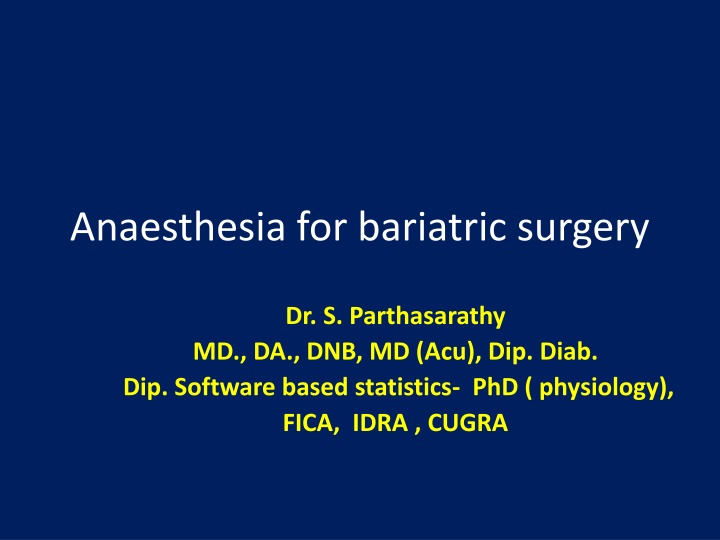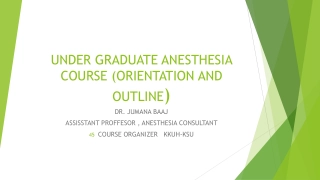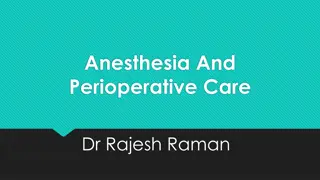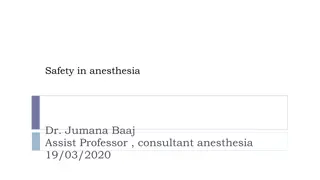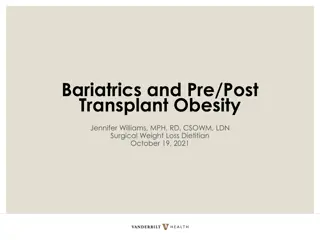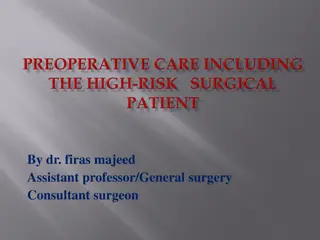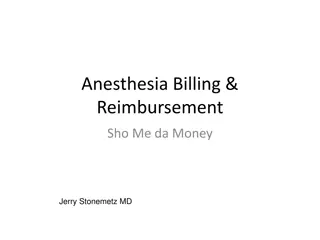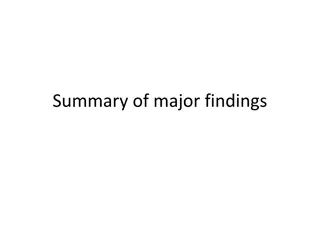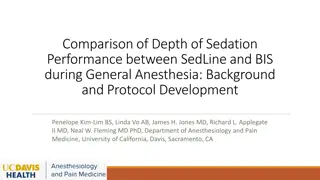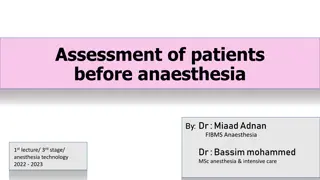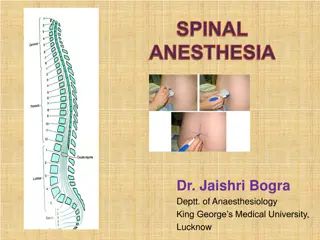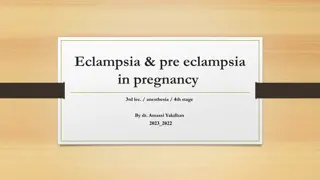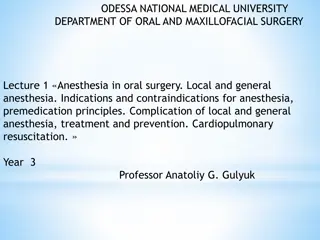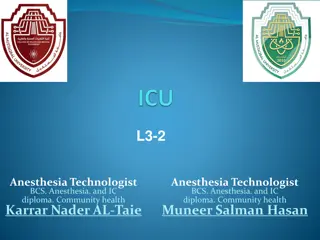Comprehensive Guide to Anesthesia for Bariatric Surgery
Bariatric surgery involves surgical modifications to the stomach or small intestine to facilitate weight loss. It is recommended for individuals who have not achieved significant weight loss with conventional treatments. Various types of bariatric surgeries are available, including malabsorptive and restrictive procedures. Anesthesia concerns for bariatric surgery revolve around combining laparoscopic techniques with addressing obesity-related issues. Pre-operative evaluations, ideal body weight calculations, and specific drug treatments are integral parts of the surgical process.
Download Presentation

Please find below an Image/Link to download the presentation.
The content on the website is provided AS IS for your information and personal use only. It may not be sold, licensed, or shared on other websites without obtaining consent from the author.If you encounter any issues during the download, it is possible that the publisher has removed the file from their server.
You are allowed to download the files provided on this website for personal or commercial use, subject to the condition that they are used lawfully. All files are the property of their respective owners.
The content on the website is provided AS IS for your information and personal use only. It may not be sold, licensed, or shared on other websites without obtaining consent from the author.
E N D
Presentation Transcript
Anaesthesia for bariatric surgery Dr. S. Parthasarathy MD., DA., DNB, MD (Acu), Dip. Diab. Dip. Software based statistics- PhD ( physiology), FICA, IDRA , CUGRA
What is it ? The term bariatric surgery refers to surgical alteration of the small intestine or stomach with a view toward producing weight loss Six months treatment - drugs , lifestyle modifications Less than 5% loss or a weight gain Consider surgery !!
Malabsorbtive jejuno-ileal bypass, and biliopancreatic bypass, Restrictive procedures include the vertical banded gastroplasty (VBG) and gastric banding, including adjustable gastric banding (AGB). Laparoscopic Roux-en-Y gastric bypass (RYGB)
What is this bariatric surgery with regard to anesthesia concerns ? A combination of laparoscopic and obesity Two uses 1. weight loss 2. better - endocrine diseases
Some surgeries Pictures modified from the internet for closed academic purpose only
Three weight Actual body weight Ideal body weight {height 100 (Men)} {(Height 110) for women} Lean body weight : (Men) LBW = 80% IBW (Women) LBW = 75% IBW
Three weight Height = 150 cm Weight 100 kg Actual = 100 Ideal body weight = 150 - 100 = 50 Kg Lean body mass = 80 % of 50 kg = 40 kg
Pre-operative Evaluation: Airway Mallampatti 3 and neck circumference > 40 cm 40 cm just ok > 60 cm definite airway difficulty
Preoperative drugs !! see the definition of bariatric surgery Sibutramine treatment include dry mouth, insomnia, anorexia, and constipation Fenfluramine and serotonin uptake Drugs for systemic illness Bad diet vitamin deficiencies think of vitamin K
Pre-operative Evaluation: OSAS ( AHI more than 10 ) CPAP of >10 Systemic illness like diabetes hypertension Is there a pulmonary hypertension echo shows TR ? Think of PHT Peripheral and central venous access and arterial cannulation sites should be evaluated during the preoperative examination ABG for CO2 LFT , RFT, B12
In premedication H2 receptor antagonists-- PPI Midazolam Heparin - compression stockings size ? Only in feet possible ? Physio education Along with antibiotics ? 5 % incidence of wound infections
Intraoperative Considerations Table Normal tables upto 205 kg Select a table of 400 kg with extra width
soft pads in various sizes and shapes filled with thousands of tiny plastic beads The patient is positioned on the bean bag, then moulded around the patient, Suction line is attached to it, a vacuum inside the bean bag which allows outside atmospheric pressure to force the beads together so they cannot move.
Positioning Beware of positional nerve injuries Even skin necrosis can happen Strong stir ups for lithotomy Can we just change some position after 30 minutes ? Rare rhabdomyolysis from gluteus muscle injury
Why are they prone for aspiration !! High incidence hiatal hernia and GERD Diabetic with gastroparesis Increased abdominal pressure (laparoscopy, lithotomy) Previous gastric banding Possible increased gastric volume
Trendelenberg Obesity Increased IAP Packs in the abdomen See how she will breathe !!
Only for very short procedures spontaneous breathing Otherwise controlled Preoxygenation after LMA !! Desflurane suxa and then rocuronium
Intraoperative period 13 ml / kg tidal volume 10 cm PEEP 55 cm good TV followed by PEEP Large blood pressure cuffs Neuromuscular monitoring IVC filter and central vein USG must
IV fluids needed are greater than predicted, and even a relatively short, 2- to 3-hour case may need 4 to 5 L of crystalloid fluid to prevent acute tubular necrosis (ATN) in the kidneys
Drug dosage to which weight !! 140 kg Thio 140 * 5 mg = 700 mg?? benzodiazepines and barbiturates are highly fat soluble , ideal body weight less fat-soluble drugs NDPs Lean Body Mass succinylcholine, which should be dosed to total body weight
Dexmedetomidine Ideal Local anesthetics - IBW TIVA total
Regional anaesthesia Safety - as airway is safe ? Alone ?? USG guided blocks Spinal, epidural Locating the space and technical difficulty Needle length
Recovery Reverse with NMJ CPAP with tube for some time temperature !! extubate wide-awake in the sitting position NSAIDs, paracetamol I.M. injections should be avoided because of unpredictable absorption Use a spinal needle !! Oxygen usually for 72 hours ! , CPAP
Innumerable postop complications reported Bleeding Infection Dehydration Peritonitis Bowel obstruction Perforation Pneumonia DVT or PE Pain !! PCA morphine/fentanyl Wound infiltration Ketoroloc Paracetomol epidural opioids !!
Summary Definition Essence Types Three weight Preoperative Which drug which weight Recovery Post op
